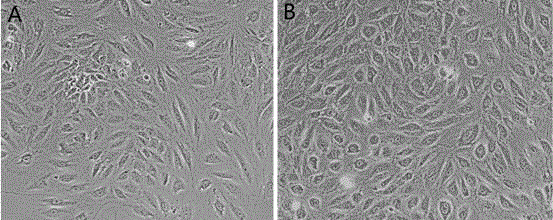Method for isolated culture of umbilical vein endothelial cell
A vascular endothelial, separation and culture technology, applied in the direction of vascular endothelial cells, tissue culture, animal cells, etc., can solve the problems of easy contamination by other cells, large amount of enzymes, leakage, etc., to achieve high cell adhesion efficiency and less pollution , the effect of simple operation
- Summary
- Abstract
- Description
- Claims
- Application Information
AI Technical Summary
Problems solved by technology
Method used
Image
Examples
Embodiment 1
[0031] Implementation Example 1 Carry out the extraction of umbilical vein endothelial cells according to this scheme
[0032] This example uses neonatal umbilical cords with maternal consent as the source of umbilical vein endothelial cells.
[0033] The reagents used in this experiment are as follows: type II collagenase (Sigma), α-MEM medium (Hyclone, Cat.No.SH30265.01B), vascular endothelial growth factor VEGF (Peprotech), fibroblast growth factor FGF (Peprotech ), fetal bovine serum FBS (Gibco), trypsin (Hyclone).
[0034] (1) Wash the neonatal umbilical cord (about 10 cm) three times in normal saline containing 1% double antibody to remove the blood stains on the surface, use sterile ophthalmic scissors to cut the umbilical cord into a small mouth about 0.5 cm along the umbilical vein, and then use sterile Remove the umbilical cord along the longitudinal direction of the umbilical vein with sterile dressing forceps, so that the umbilical vein is completely exposed, and ...
Embodiment 2
[0038] Implementation Example 2 Extraction of Umbilical Vein Endothelial Cells by Collagenase Perfusion
[0039] The reagents used in this experiment are the same as in Example 1.
[0040]The separation of umbilical vein endothelial cells was carried out according to the traditional collagenase perfusion method. Since the method is relatively mature, it will not be repeated here. During the digestion process, the type II collagenase with a mass volume concentration of 0.05% was used to digest for 25 min, and after the cells were collected, 5×10 4 / well into a 6-well plate, placed in 37 ° C, 5% CO 2 After 24 hours, the medium was changed to remove floating red blood cells. After 3 days, the medium was replaced with medium B. Cells were subcultured after the degree of cell confluence reached 80%, and medium B was used in the subsequent culture process. The final concentration of fetal bovine serum FBS in medium A was 20%, the final concentrations of basic fibroblast growth fac...
Embodiment 3
[0043] Compared with Example 1, in the step (3) of this example, type II collagenase was used at a mass volume concentration of 0.1% for 10 cm blood vessels, and the digestion time was 15 minutes, and the rest was the same as that of Example 1.
[0044] In embodiment example 3, 10cm umbilical cord obtains initial cell number and is 1.8 * 10 5 , it takes 144h for the cells to grow to 80% confluence.
PUM
 Login to View More
Login to View More Abstract
Description
Claims
Application Information
 Login to View More
Login to View More - R&D
- Intellectual Property
- Life Sciences
- Materials
- Tech Scout
- Unparalleled Data Quality
- Higher Quality Content
- 60% Fewer Hallucinations
Browse by: Latest US Patents, China's latest patents, Technical Efficacy Thesaurus, Application Domain, Technology Topic, Popular Technical Reports.
© 2025 PatSnap. All rights reserved.Legal|Privacy policy|Modern Slavery Act Transparency Statement|Sitemap|About US| Contact US: help@patsnap.com



